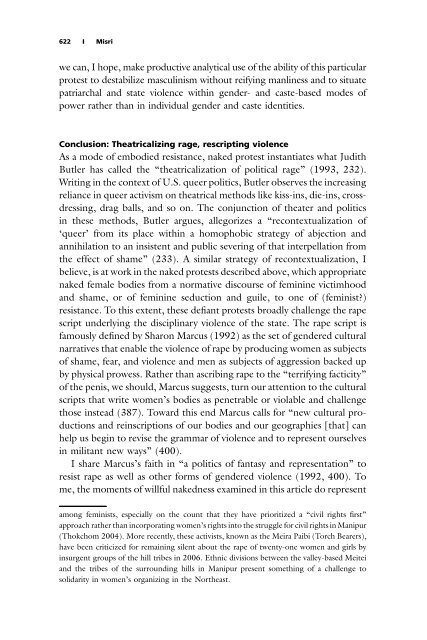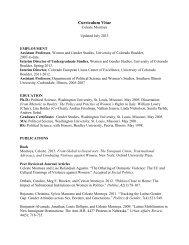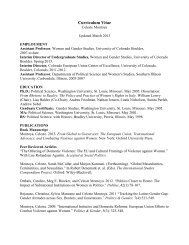Are you a man?: Performing Naked Protest in India - Women and ...
Are you a man?: Performing Naked Protest in India - Women and ...
Are you a man?: Performing Naked Protest in India - Women and ...
You also want an ePaper? Increase the reach of your titles
YUMPU automatically turns print PDFs into web optimized ePapers that Google loves.
622 ❙ Misri<br />
we can, I hope, make productive analytical use of the ability of this particular<br />
protest to destabilize mascul<strong>in</strong>ism without reify<strong>in</strong>g <strong>man</strong>l<strong>in</strong>ess <strong>and</strong> to situate<br />
patriarchal <strong>and</strong> state violence with<strong>in</strong> gender- <strong>and</strong> caste-based modes of<br />
power rather than <strong>in</strong> <strong>in</strong>dividual gender <strong>and</strong> caste identities.<br />
Conclusion: Theatricaliz<strong>in</strong>g rage, rescript<strong>in</strong>g violence<br />
As a mode of embodied resistance, naked protest <strong>in</strong>stantiates what Judith<br />
Butler has called the “theatricalization of political rage” (1993, 232).<br />
Writ<strong>in</strong>g <strong>in</strong> the context of U.S. queer politics, Butler observes the <strong>in</strong>creas<strong>in</strong>g<br />
reliance <strong>in</strong> queer activism on theatrical methods like kiss-<strong>in</strong>s, die-<strong>in</strong>s, crossdress<strong>in</strong>g,<br />
drag balls, <strong>and</strong> so on. The conjunction of theater <strong>and</strong> politics<br />
<strong>in</strong> these methods, Butler argues, allegorizes a “recontextualization of<br />
‘queer’ from its place with<strong>in</strong> a homophobic strategy of abjection <strong>and</strong><br />
annihilation to an <strong>in</strong>sistent <strong>and</strong> public sever<strong>in</strong>g of that <strong>in</strong>terpellation from<br />
the effect of shame” (233). A similar strategy of recontextualization, I<br />
believe, is at work <strong>in</strong> the naked protests described above, which appropriate<br />
naked female bodies from a normative discourse of fem<strong>in</strong><strong>in</strong>e victimhood<br />
<strong>and</strong> shame, or of fem<strong>in</strong><strong>in</strong>e seduction <strong>and</strong> guile, to one of (fem<strong>in</strong>ist)<br />
resistance. To this extent, these defiant protests broadly challenge the rape<br />
script underly<strong>in</strong>g the discipl<strong>in</strong>ary violence of the state. The rape script is<br />
famously def<strong>in</strong>ed by Sharon Marcus (1992) as the set of gendered cultural<br />
narratives that enable the violence of rape by produc<strong>in</strong>g women as subjects<br />
of shame, fear, <strong>and</strong> violence <strong>and</strong> men as subjects of aggression backed up<br />
by physical prowess. Rather than ascrib<strong>in</strong>g rape to the “terrify<strong>in</strong>g facticity”<br />
of the penis, we should, Marcus suggests, turn our attention to the cultural<br />
scripts that write women’s bodies as penetrable or violable <strong>and</strong> challenge<br />
those <strong>in</strong>stead (387). Toward this end Marcus calls for “new cultural productions<br />
<strong>and</strong> re<strong>in</strong>scriptions of our bodies <strong>and</strong> our geographies [that] can<br />
help us beg<strong>in</strong> to revise the grammar of violence <strong>and</strong> to represent ourselves<br />
<strong>in</strong> militant new ways” (400).<br />
I share Marcus’s faith <strong>in</strong> “a politics of fantasy <strong>and</strong> representation” to<br />
resist rape as well as other forms of gendered violence (1992, 400). To<br />
me, the moments of willful nakedness exam<strong>in</strong>ed <strong>in</strong> this article do represent<br />
among fem<strong>in</strong>ists, especially on the count that they have prioritized a “civil rights first”<br />
approach rather than <strong>in</strong>corporat<strong>in</strong>g women’s rights <strong>in</strong>to the struggle for civil rights <strong>in</strong> Manipur<br />
(Thokchom 2004). More recently, these activists, known as the Meira Paibi (Torch Bearers),<br />
have been criticized for rema<strong>in</strong><strong>in</strong>g silent about the rape of twenty-one women <strong>and</strong> girls by<br />
<strong>in</strong>surgent groups of the hill tribes <strong>in</strong> 2006. Ethnic divisions between the valley-based Meitei<br />
<strong>and</strong> the tribes of the surround<strong>in</strong>g hills <strong>in</strong> Manipur present someth<strong>in</strong>g of a challenge to<br />
solidarity <strong>in</strong> women’s organiz<strong>in</strong>g <strong>in</strong> the Northeast.






